Indoor Clothes Drying: A Cost-Saving Alternative with Hidden Risks
As many Irish households grapple with the rising cost of living, the trend of indoor clothes drying has gained momentum as a money-saving alternative to energy-draining tumble dryers. However, this seemingly frugal practice can have unforeseen consequences, leading to the growth of mould that not only poses health risks but can also result in expensive damages to your home.
The Story So Far
In a world where every penny counts, the choice between using a tumble dryer and opting for indoor clothes drying seems like a no-brainer. But what if this seemingly harmless decision could have far-reaching consequences? As families across Ireland embrace the practice of drying clothes indoors to cut down on utility costs, little do they realize the potential dangers lurking in the shadows.
Full Review
In a bid to save money and reduce their carbon footprint, more and more households are turning to indoor clothes drying. However, what starts as a cost-saving measure can quickly turn into a nightmare if proper precautions are not taken. The article sheds light on the hidden risks associated with indoor clothes drying, particularly the growth of mould that can have detrimental effects on both health and home maintenance.
The Dangers of Mould Growth
Indoor clothes drying creates a humid environment that is conducive to mould growth. This not only leads to an unpleasant musty smell but can also trigger allergies and respiratory issues in sensitive individuals. Moreover, mould can damage walls, ceilings, and furniture, resulting in costly repairs and potentially compromising the structural integrity of your home.
Prevention and Mitigation Strategies
To mitigate the risks associated with indoor clothes drying, it is essential to take proactive measures. Using dehumidifiers, opening windows for ventilation, and rotating drying locations can help reduce humidity levels and prevent mould growth. Additionally, regularly inspecting and cleaning areas prone to mould, such as bathrooms and laundry rooms, can go a long way in maintaining a healthy living environment.
The Cost of Ignoring the Risks
While the allure of saving money may be tempting, the consequences of neglecting the risks of indoor clothes drying can far outweigh the benefits. From health issues to structural damage, the hidden dangers of mould growth can have a lasting impact on your well-being and financial stability. By being aware of these risks and taking appropriate precautions, you can enjoy the benefits of indoor clothes drying without putting your health and home at risk.
Conclusion
In conclusion, while indoor clothes drying may seem like a practical solution to cut down on energy costs, it is essential to be mindful of the potential risks it poses. By understanding the dangers of mould growth and implementing preventive measures, you can enjoy the benefits of indoor drying without compromising your health and home. Remember, a little caution goes a long way in safeguarding your well-being and ensuring a safe living environment for you and your family.
Frequently Asked Questions
1. What are the health risks associated with mould growth from indoor clothes drying?
Mould growth from indoor clothes drying can lead to respiratory issues, allergies, and other health concerns.
2. How can I prevent mould growth when drying clothes indoors?
Using dehumidifiers, ensuring proper ventilation, and inspecting/cleaning areas prone to mould can help prevent growth.
3. What are the signs of mould growth in my home?
Visible mould, musty odours, and moisture buildup are common signs of mould growth in homes.
4. Can mould growth from indoor clothes drying be harmful to children and pets?
Yes, mould growth can pose health risks to both children and pets, especially those with allergies or respiratory conditions.
5. How often should I inspect areas prone to mould in my home?
Regular inspections, at least once a month, are recommended to catch any signs of mould growth early on.
6. Are there any eco-friendly alternatives to indoor clothes drying?
Options like outdoor drying, using drying racks, or investing in energy-efficient tumble dryers can be more environmentally friendly alternatives.
7. What should I do if I suspect mould growth in my home?
If you suspect mould growth in your home, it is best to consult with a professional mould remediation specialist for proper assessment and treatment.
8. Can mould growth from indoor clothes drying damage my home’s structure?
Yes, prolonged mould growth can damage walls, ceilings, and other structural components of your home, leading to costly repairs.
9. How important is ventilation when drying clothes indoors?
Proper ventilation is crucial when drying clothes indoors to prevent humidity buildup and inhibit mould growth.
10. What are the long-term effects of exposure to mould in homes?
Long-term exposure to mould can exacerbate respiratory conditions, trigger allergies, and compromise overall indoor air quality.
Tags: indoor clothes drying, mould growth, health risks, home maintenance, prevention strategies, cost-saving alternatives, hidden dangers

